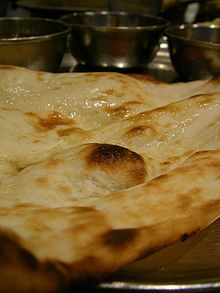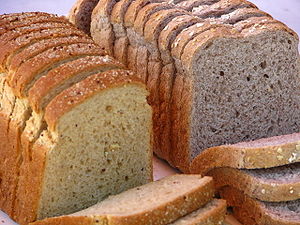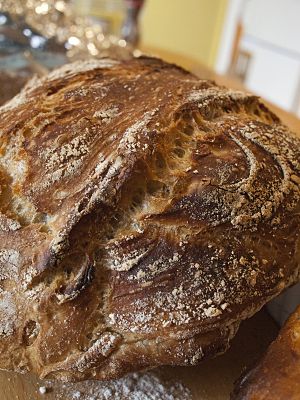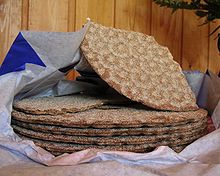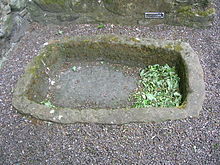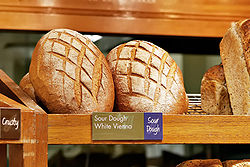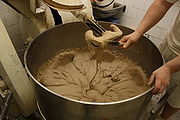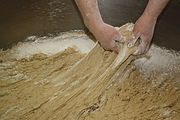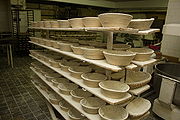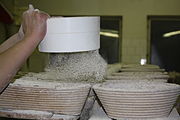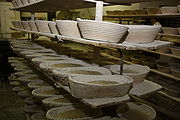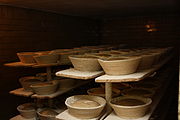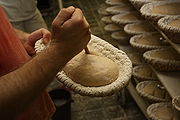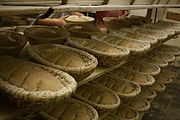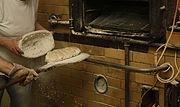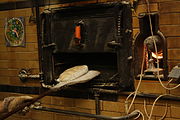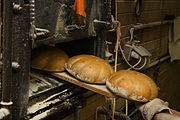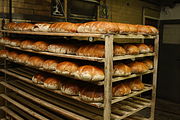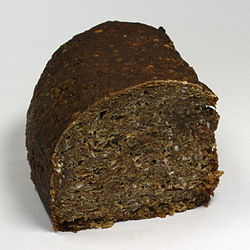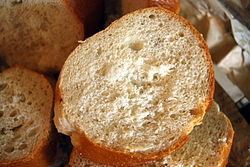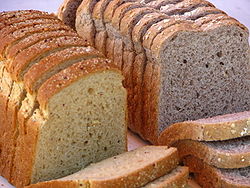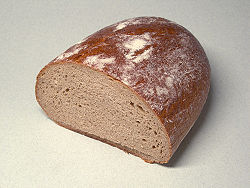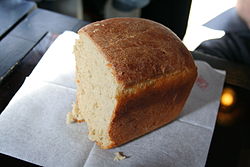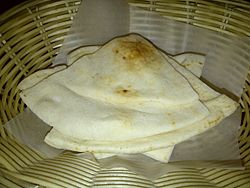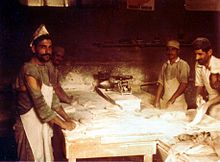
Bread
Did you know...
SOS Children has tried to make Wikipedia content more accessible by this schools selection. A quick link for child sponsorship is http://www.sponsor-a-child.org.uk/
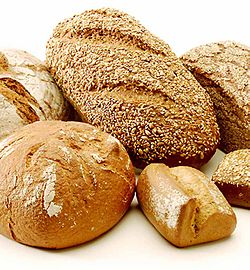 Various leavened breads |
|
| Details | |
|---|---|
| Main ingredient(s) | Flour, water |
| Nutritional value per 100 g (3.5 oz) | |
|---|---|
| Energy | 1,113 kJ (266 kcal) |
| Carbohydrates | 51 g |
| - Dietary fibre | 2.4 g |
| Fat | 3 g |
| Protein | 8 g |
| Thiamine (vit. B1) | 0.5 mg (43%) |
| Riboflavin (vit. B2) | 0.3 mg (25%) |
| Niacin (vit. B3) | 4 mg (27%) |
| Folate (vit. B9) | 111 μg (28%) |
| Choline | 14.6 mg (3%) |
| Vitamin K | 3.1 μg (3%) |
| Calcium | 151 mg (15%) |
| Iron | 3.74 mg (29%) |
| Magnesium | 23 mg (6%) |
| Potassium | 100 mg (2%) |
| Sodium | 681 mg (45%) |
| Percentages are relative to US recommendations for adults. |
|
| Nutritional value per 100 g (3.5 oz) | |
|---|---|
| Energy | 1,034 kJ (247 kcal) |
| Carbohydrates | 41 g |
| - Dietary fibre | 7 g |
| Fat | 3 g |
| Protein | 13 g |
| Thiamine (vit. B1) | 0.4 mg (35%) |
| Riboflavin (vit. B2) | 0.2 mg (17%) |
| Niacin (vit. B3) | 4.7 mg (31%) |
| Folate (vit. B9) | 50 μg (13%) |
| Choline | 26.5 mg (5%) |
| Vitamin K | 7.8 μg (7%) |
| Calcium | 107 mg (11%) |
| Iron | 2.43 mg (19%) |
| Magnesium | 82 mg (23%) |
| Potassium | 248 mg (5%) |
| Sodium | 472 mg (31%) |
| Percentages are relative to US recommendations for adults. |
|
Bread is a staple food prepared by baking a dough of flour and water and often additional ingredients, such as butter or salt to improve the taste.
Etymology
The word itself, Old English bread, is common in various forms to many Germanic languages, such as Frisian brea, Dutch brood, German Brot, Swedish bröd, and Norwegian and Danish brød; it has been claimed to be derived from the root of brew. It may be connected with the root of break, for its early uses are confined to broken pieces or bits of bread, the Latin crustum, and it was not until the 12th century that it took the place—as the generic name for bread—of hlaf (𐌷𐌻𐌰𐌹𐍆𐍃 [hlaifs] in Gothic: modern English loaf), which appears to be the oldest Teutonic name. Old High German hleib and modern German Laib derive from this Proto-Germanic word for "loaf", and it is coradical with Polish chleb, Russian хлеб (khleb), and borrowed into Finnish leipä and Estonian leib as well.
History
Bread is one of the oldest prepared foods. Evidence from 30,000 years ago in Europe revealed starch residue on rocks used for pounding plants. It is possible that during this time, starch extract from the roots of plants, such as cattails and ferns, was spread on a flat rock, placed over a fire and cooked into a primitive form of flatbread. Around 10,000 BC, with the dawn of the Neolithic age and the spread of agriculture, grains became the mainstay of making bread. Yeast spores are ubiquitous, including the surface of cereal grains, so any dough left to rest will become naturally leavened.
There were multiple sources of leavening available for early bread. Airborne yeasts could be harnessed by leaving uncooked dough exposed to air for some time before cooking. Pliny the Elder reported that the Gauls and Iberians used the foam skimmed from beer to produce "a lighter kind of bread than other peoples." Parts of the ancient world that drank wine instead of beer used a paste composed of grape juice and flour that was allowed to begin fermenting, or wheat bran steeped in wine, as a source for yeast. The most common source of leavening was to retain a piece of dough from the previous day to use as a form of sourdough starter.
A major advance to the bread making process occurred in 1961 with the development of the Chorleywood bread process, which used the intense mechanical working of dough to dramatically reduce the fermentation period and the time taken to produce a loaf. The process, whose high-energy mixing allows for the use of lower protein grain, is now widely used around the world in large factories. As a result, bread can be produced very quickly and at low costs to the manufacturer and the consumer. However there has been some criticism of the effect on nutritional value.
Recently, domestic bread machines that automate the process of making bread have become popular.
Cultural and political importance of bread
Bread has a significance beyond mere nutrition in many cultures in the West and Near and Middle East because of its history and contemporary importance. Bread is also significant in Christianity as one of the elements (alongside wine) of the Eucharist; see sacramental bread. The word companion comes from Latin com- "with" + panis "bread".
In many cultures, bread is a metaphor for basic necessities and living conditions in general. For example, a "bread-winner" is a household's main economic contributor and has little to do with actual bread-provision. This is also seen in the phrase "putting bread on the table". The Roman poet Juvenal satirised superficial politicians and the public as caring only for "panem et circenses" ( bread and circuses). A remarkable or revolutionary innovation is often referred to as " the greatest thing since sliced bread". For example, the Lord's Prayer, contains the line "Give us this day our daily bread"; here, "bread" is commonly understood to mean necessities in general. In Russia in 1917, the Bolsheviks promised "peace, land, and bread." The term " breadbasket" denotes an agriculturally productive region. In Slavic cultures bread and salt is offered as a welcome to guests. In India, life's basic necessities are often referred to as "roti, kapra aur makan" (bread, cloth, and house). In Israel, the most usual phrase in work-related demonstrations is lekhem, avoda ("bread, work").
The political significance of bread is considerable. In 19th century Britain, the inflated price of bread due to the Corn Laws caused major political and social divisions, and was central to debates over free trade versus protectionism. The Assize of Bread and Ale in the 13th century demonstrated the importance of bread in medieval times by setting heavy punishments for short-changing bakers, and bread appeared in the Magna Carta a half-century earlier.
Like other foods, choosing the "right" kind of bread is used as a type of social signalling, to let others know, for example, that the person buying expensive bread is financially secure, or the person buying whatever type of bread that the current fashions deem most healthful is a health-conscious consumer.
The word bread is commonly used around the world in English-speaking countries as a synonym for money (as is the case with the word " dough"). In Cockney rhyming slang, bread means money; this usage is derived from the phrase "bread and honey". Dring the 1950s the beatnik community used the term bread as a euphemism for money.
In particular religions
Christian traditional societies (usually in poor communities) used to respect bread becayse it symbolises the body of Jesus. The sign of the cross was performed with the knife on the bread's surface, before the loaf was cut. Sometimes, it was considered a sin to desecrate bread (such as throw it away).
Jews have traditionally baked challah, a type of egg bread with a thin, hard crust and a soft, well-leavened centre. It is made by wrapping plaits of dough and then lightly baking them in an oven. Challah is sometimes sweetened using honey and sometimes includes raisins. During Passover, unleavened bread, in the form of various types of matzo, is required due to the Biblical injunction to avoid any form of leaven during this time of year. There is some debate within the Jewish community as to whether dairy products are allowed in kosher bread; some authorities maintain that bread must be strictly pareve to avoid combining meat and dairy in the same meal, while others feel it is acceptable as long as a sign of some sort (usually a different loaf shape, but others are known) is baked into the loaf to distinguish it from pareve bread.
In Wicca, bread and wine are often consumed together during rituals to remind followers that the gods provide everything needed to sustain humanity.
Types
Bread is the staple food in Europe, European-derived cultures such as the Americas, and the Middle East and North Africa, as opposed to East Asia whose staple is rice. Bread is usually made from a wheat- flour dough that is cultured with yeast, allowed to rise, and finally baked in an oven. Owing to its high levels of gluten (which give the dough sponginess and elasticity), common wheat (also known as bread wheat) is the most common grain used for the preparation of bread.
Bread is also made from the flour of other wheat species (including durum, spelt and emmer), rye, barley, maize (corn), and oats, usually, but not always, in combination with wheat flour. Spelt bread (Dinkelbrot) continues to be widely consumed in Germany, and emmer bread was a staple food in ancient Egypt. Canadian bread is known for its heartier consistency due to high protein levels in Canadian flour.
- White bread is made from flour containing only the central core of the grain (endosperm).
- Brown bread is made with endosperm and 10% bran. It can also refer to white bread with added colouring (often caramel colouring) to make it brown; this is commonly labeled in America as wheat bread (as opposed to whole-wheat bread).
- Wholemeal bread contains the whole of the wheat grain (endosperm, bran, and germ). It is also referred to as "whole-grain" or "whole-wheat bread", especially in North America.
- Wheat germ bread has added wheat germ for flavoring.
- Whole-grain bread can refer to the same as wholemeal bread, or to white bread with added whole grains to increase its fibre content, as in "60% whole-grain bread".
- Roti is a whole-wheat-based bread eaten in South Asia. Chapatti is a larger variant of roti. Naan is a leavened equivalent to these.
- Granary bread is made from flaked wheat grains and white or brown flour. The standard malting process is modified to maximise the maltose or sugar content but minimise residual alpha amylase content. Other flavour components are imparted from partial fermentation due to the particular malting process used and to Maillard reactions on flaking and toasting.
- Rye bread is made with flour from rye grain of varying levels. It is higher in fiber than many common types of bread and is often darker in colour and stronger in flavor. It is popular in Scandinavia, Germany, Finland, the Baltic States, and Russia.
- Unleavened bread or matzo, used for the Jewish feast of Passover, does not include yeast, so it does not rise.
- Sourdough bread is made with a starter.
- Flatbread is often simple, made with flour, water, and salt, and then formed into flattened dough; most are unleavened, made without yeast or sourdough culture, though some are made with yeast.
- Hempbread Hemp seeds do not mill into flour because of their high oil content (~30%). Hemp flour is the by-product after pressing the oil and milling the residue. Hemp flour doesn't rise, and is best mixed with other flours. A 3:1 ratio produces a hearty, heavy, nutritious loaf high in protein and essential fatty acids.
- Crisp bread is a flat and dry type of bread or cracker, containing mostly rye flour.
Quick breads
The term quick bread usually refers to a bread chemically leavened, usually with both baking powder and baking soda, and a balance of acidic ingredients and alkaline ingredients. Examples include pancakes and waffles, muffins and carrot cake, Boston brown bread, and zucchini and banana bread.
Bread making
Doughs are usually baked, but in some cuisines breads are steamed (e.g., mantou), fried (e.g., puri), or baked on an unoiled frying pan (e.g., tortillas). It may be leavened or unleavened (e.g. matzo). Salt, fat and leavening agents such as yeast and baking soda are common ingredients, though bread may contain other ingredients, such as milk, egg, sugar, spice, fruit (such as raisins), vegetables (such as onion), nuts (such as walnuts) or seeds (such as poppy). Referred to colloquially as the "staff of life", bread has been prepared for at least 30,000 years. The development of leavened bread can probably also be traced to prehistoric times. Sometimes, the word bread refers to a sweetened loaf cake, often containing appealing ingredients like dried fruit, chocolate chips, nuts or spices, such as pumpkin bread, banana bread or gingerbread.
Fresh bread is prized for its taste, aroma, quality, appearance and texture. Retaining its freshness is important to keep it appetizing. Bread that has stiffened or dried past its prime is said to be stale. Modern bread is sometimes wrapped in paper or plastic film or stored in a container such as a breadbox to reduce drying. Bread that is kept in warm, moist environments is prone to the growth of mold. Bread kept at low temperatures, in a refrigerator for example, will develop mold growth more slowly than bread kept at room temperature, but will turn stale quickly due to retrogradation.
The soft, inner part of bread is known to bakers and other culinary professionals as the crumb, which is not to be confused with small bits of bread that often fall off, called crumbs. The outer hard portion of bread is called the crust.
Formulation
Professional baker recipes are stated using a notation called baker's percentage. The amount of flour is denoted to be 100%, and the amounts of the other ingredients are expressed as a percentage of that amount by weight. Measurement by weight is more accurate and consistent than measurement by volume, particularly for dry ingredients.
The proportion of water to flour is the most important measurement in a bread recipe, as it affects texture and crumb the most. Hard US wheat flours absorb about 62% water, while softer wheat flours absorb about 56%. Common table breads made from these doughs result in a finely textured, light bread. Most artisan bread formulas contain anywhere from 60 to 75% water. In yeast breads, the higher water percentages result in more CO2 bubbles and a coarser bread crumb. One pound (450 g) of flour will yield a standard loaf of bread or two French loaves.
Calcium propionate is commonly added by commercial bakeries to retard the growth of molds.
Flour
Flour is a product made from grain that has been ground to a powdery consistency. Flour provides the primary structure to the final baked bread. While wheat flour is most commonly used for breads, flours made from rye, barley, maize, and other grains are also commonly available. Each of these grains provides the starch and protein needed to form bread.
The protein content of the flour is the best indicator of the quality of the bread dough and the finished bread. While bread can be made from all-purpose wheat flour, a specialty bread flour, containing more protein (12-14%), is recommended for high-quality bread. If one uses a flour with a lower protein content (9–11%) to produce bread, a shorter mixing time will be required to develop gluten strength properly. An extended mixing time leads to oxidization of the dough, which gives the finished product a whiter crumb, instead of the cream colour preferred by most artisan bakers.
Wheat flour, in addition to its starch, contains three water-soluble protein groups ( albumin, globulin, and proteoses) and two water-insoluble protein groups ( glutenin and gliadin). When flour is mixed with water, the water-soluble proteins dissolve, leaving the glutenin and gliadin to form the structure of the resulting bread. When relatively dry dough is worked by kneading, or wet dough is allowed to rise for a long time (see no-knead bread), the glutenin forms strands of long, thin, chainlike molecules, while the shorter gliadin forms bridges between the strands of glutenin. The resulting networks of strands produced by these two proteins are known as gluten. Gluten development improves if the dough is allowed to autolyse.
Liquids
Water, or some other liquid, is used to form the flour into a paste or dough. The weight of liquid required varies between recipes, but a ratio of 3 parts liquid to 5 parts flour is common for yeast breads. Recipes that use steam as the primary leavening method may have a liquid content in excess of 1 part liquid to 1 part flour. Instead of water, other types of liquids, such as dairy products, fruit juices, or beer, may be used; they contribute additional sweeteners, fats, or leavening components, as well as water.
Leavening
Leavening is the process of adding gas to a dough before or during baking to produce a lighter, more easily chewed bread. Most bread consumed in the West is leavened. Unleavened breads have symbolic importance in Judaism and Christianity. Jews consume unleavened bread called matzo during Passover. Roman Catholic and some Protestant Christians consume unleavened bread during the Christian liturgy when they celebrate the Eucharist, a rite derived from the narrative of the Last Supper when Jesus broke bread with his disciples, perhaps during a Passover Seder. In contrast, Orthodox Christians always use leavened bread during their liturgy.
Chemical leavening
A simple technique for leavening bread is the use of gas-producing chemicals. There are two common methods. The first is to use baking powder or a self-rising flour that includes baking powder. The second is to include an acidic ingredient such as buttermilk and add baking soda; the reaction of the acid with the soda produces gas.
Chemically leavened breads are called quick breads and soda breads. This method is commonly used to make muffins, pancakes, American-style biscuits, and quick breads such as banana bread.
Yeast
Many breads are leavened by yeast. The yeast most commonly used for leavening bread is Saccharomyces cerevisiae, the same species used for brewing alcoholic beverages. This yeast ferments some of the carbohydrates in the flour, including any sugar, producing carbon dioxide. Most bakers in the U.S. leaven their dough with commercially produced baker's yeast. Baker's yeast has the advantage of producing uniform, quick, and reliable results, because it is obtained from a pure culture. Many artisan bakers produce their own yeast by preparing a growth culture that they then use in the making of bread. When this culture is kept in the right conditions, it will continue to grow and provide leavening for many years.
Both the baker's yeast and the sourdough methods of baking bread follow the same pattern. Water is mixed with flour, salt and the leavening agent (baker's yeast or sourdough starter). Other additions (spices, herbs, fats, seeds, fruit, etc.) are not needed to bake bread, but are often used. The mixed dough is then allowed to rise one or more times (a longer rising time results in more flavor, so bakers often "punch down" the dough and let it rise again), then loaves are formed, and (after an optional final rising time) the bread is baked in an oven.
Many breads are made from a "straight dough", which means that all of the ingredients are combined in one step, and the dough is baked after the rising time; others are made from a " pre-ferment" in which the leavening agent is combined with some of the flour and water a day or so ahead of baking and allowed to ferment overnight. On the day of the baking, the rest of the ingredients are added, and process continues as with straight dough. This produces a more flavorful bread with better texture.
Many bakers see the starter method as a compromise between the highly reliable results of baker's yeast and the flavor and complexity of a longer fermentation. It also allows the baker to use only a minimal amount of baker's yeast, which was scarce and expensive when it first became available. Most yeasted pre-ferments fall into one of three categories: " poolish" or "pouliche", a loose-textured mixture composed of roughly equal amounts of flour and water (by weight); " biga", a stiff mixture with a higher proportion of flour; and "pâte fermentée", which is simply a portion of dough reserved from a previous batch. Sourdough (also known as "levain" or "natural leaven") takes the pre-ferment method a step further, mixing flour and water to allow naturally occurring yeast and bacteria to propagate (usually Saccharomyces exiguus, which is more acid-tolerant than S. cerevisiae and various species of Lactobacillus).
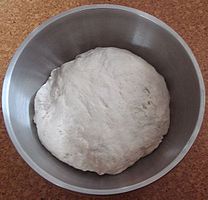 |
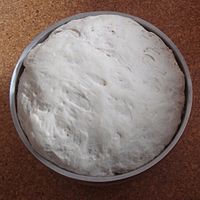 |
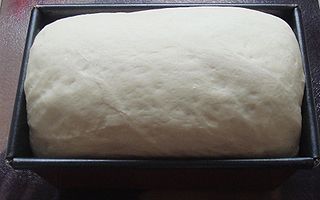 |
| Dough before first rising. | Dough after first rising. | Dough after proofing in tin, ready to bake. |
Sourdough
Sourdough is a type of bread produced by a long fermentation of dough using naturally occurring yeasts and lactobacilli. In comparison with breads made with cultivated yeast, it usually has a mildly sour taste because of the lactic acid produced by the lactobacilli.
Sourdough breads are made with a sourdough starter (which differs from starters made with baker's yeast). The starter cultivates yeast and lactobacilli in a mixture of flour and water, making use of the microorganisms already present on flour; it does not need any added yeast. A starter may be maintained indefinitely by regular additions of flour and water. Some bakers have starters several generations old, which are said to have a special taste or texture. It is possible to obtain existing starter cultures to begin a new one.
At one time, all yeast-leavened breads were sourdoughs. The leavening process was not understood until the 19th century, when yeast was first identified. Since then, strains of Saccaromyces cerevisiae have been bred for their reliability and speed of leavening and sold as "baker's yeast". Baker's yeast was adopted for the simpicity and flexibility it introduced to bread making, obviating the lengthy cultivation of a sourdough starter. While sourdough breads survived in some parts of Europe, throughout most of the U.S., they were replaced by baker's yeast. Recently there has been a revival of sourdough bread in artisan bakeries.
There are other ways of sourdough baking and culture maintenance. A more traditional one is the process that was followed by peasant families throughout Europe in past centuries. The family (usually the woman was in charge of breadmaking) would bake on a fixed schedule, perhaps once a week. The starter was saved from the previous week's dough. The starter was mixed with the new ingredients, the dough was left to rise, and then a piece of it was saved (to be the starter for next week's bread). The rest was formed into loaves that were marked with the family sign (this is where today's decorative slashing of bread loaves originates from) and taken to the communal oven to bake. These communal ovens with time evolved into the modern bakery.
Steam
The rapid expansion of steam produced during baking leavens the bread, which is as simple as it is unpredictable. The best known steam-leavened bread is the popover. Steam-leavening is unpredictable since the steam is not produced until the bread is baked.
Steam leavening happens regardless of the rising agents (baking soda, yeast, baking powder, sour dough, beaten egg whites, etc.).
- The leavening agent either contains air bubbles or generates carbon dioxide.
- The heat vaporises the water from the inner surface of the bubbles within the dough.
- The steam expands and makes the bread rise.
This is the main factor in the rise of bread once it has been put in the oven. CO2 generation, on its own, is too small to account for the rise. Heat kills bacteria or yeast at an early stage, so the CO2 generation is stopped.
Bacteria
Salt rising bread employs a form of bacterial leavening that does not require yeast. Although the leavening action is not always consistent, and requires close attention to the incubating conditions, this bread is making a comeback due to its unique cheese-like flavor and fine texture.
Aeration
Aerated bread is leavened by carbon dioxide being forced into dough under pressure. The technique is no longer in common use, but from the mid 19th to 20th centuries bread made this way was somewhat popular in the United Kingdom, made by the Aerated Bread Company and sold in its high-street tearooms.
Fats or shortenings
Fats, such as butter, vegetable oils, lard, or that contained in eggs, affect the development of gluten in breads by coating and lubricating the individual strands of protein. They also help to hold the structure together. If too much fat is included in a bread dough, the lubrication effect will cause the protein structures to divide. A fat content of approximately 3% by weight is the concentration that will produce the greatest leavening action. In addition to their effects on leavening, fats also serve to tenderize breads and preserve freshness.
Bread improvers
Bread improvers are often used in producing commercial breads to reduce the time needed for rising and to improve texture and volume. Chemical substances commonly used as bread improvers include ascorbic acid, hydrochloride, sodium metabisulfate, ammonium chloride, various phosphates, amylase, and protease.
Salt is one of the most common additives used in production. In addition to enhancing flavor and restricting yeast activity, salt affects the crumb and the overall texture by stabilizing and strengthening the gluten. Some artisan bakers are foregoing early addition of salt to the dough, and are waiting until after a 20-minute "rest". This is known as an autolyse and is done with both refined and whole-grain flours.
Chemical composition
In wheat, phenolic compounds are mainly found in hulls in the form of insoluble bound ferulic acid where it is relevant to wheat resistance to fungal diseases.
Rye bread contains phenolic acids and ferulic acid dehydrodimers.
Three natural phenolic glucosides, secoisolariciresinol diglucoside, p-coumaric acid glucoside and ferulic acid glucoside, can be found in commercial breads containing flaxseed.
Baking
This is a visual representation of steps involved in baking bread in a commercial bakery.
| Baking of bread | ||||||||||||||||||||||||
|
||||||||||||||||||||||||
Serving and consumption
Bread can be served at any temperature; once baked, it can subsequently be toasted. It is most commonly eaten with the hands, either by itself or as a carrier for other foods. Bread can be dipped into liquids such as gravy, olive oil, or soup; it can be topped with various sweet and savory spreads, or used to make sandwiches containing myriad varieties of meats, cheeses, vegetables, and condiments.
Shelf life
In 2009, a natural preservative for extending the shelf life of bread for up to two weeks (as opposed to a few days) had been patented and licensed to Puratos, a Belgium-based baking ingredients company that supplies to more than 100 countries. The breakthrough was pioneered by Prof Elke Arendt at the University College Cork (UCC) by incorporating into the bread a lactic acid bacteria strain which also "produces a fine crumb texture" and "improves the flavour, volume and nutritional value of the food as well." Prior to this, "About 20% of all bread is thrown out due to shelf-life issues."
Crust
The bread crust is formed from surface dough during the cooking process. It is hardened and browned through the Maillard reaction using the sugars and amino acids and the intense heat at the bread surface. The nature of a bread's crust differs depending on the type of bread and the way it is baked. Commercial bread is baked using jets that direct steam toward the bread to help produce a desirable crust.
The crust of most breads is less soft, and more complexly and intensely flavored, than the rest, and judgments vary among individuals and cultures as to whether it is therefore the less palatable or the more flavorful part of a particular style of bread. Some manufacturers, including as of September 2009 Sara Lee, market traditional and crustless breads.
The first and last slices of a loaf (or a slice with a high ratio of crust-area to volume compared to others of the same loaf) are sometimes referred to as the heel or the crust of the loaf.
Old wives tales suggest that eating the bread crust makes a person's hair curlier. Additionally, the crust is rumored to be healthier than the rest. Some studies have shown that this is true as the crust has more dietary fibre and antioxidants, notably pronyl-lysine. The pronyl-lysine found in bread crust is being researched for its potential colorectal cancer inhibitory properties.
Breads in different cultures
... bread has become an article of food of the first necessity; and properly so, for it constitutes of itself a complete life-sustainer, the gluten, starch, and sugar, which it contains, represents azotised and hydro-carbonated nutrients, and combining the sustaining powers of the animal and vegetable kingdoms in one product. Mrs Beeton (1861)
As a simple, cheap, and adaptable type of food, bread is often used as a synecdoche for food in general in some languages and dialects, such as Greek and Punjabi. There are many variations on the basic recipe of bread worldwide, including pizza, chapatis, tortillas, bocadillo, baguettes, brioche, pitas, lavash, biscuits, pretzels, naan, bagels, puris, and many others. There are different types of traditional "cheese breads" in many countries, including Brazil, Colombia, Italy, and Russia.
Europe
Germany prides itself on having the largest variety of breads worldwide. More than 300 basic kinds of bread are produced with more than 1,000 types of small bread-rolls and pastries. It has been estimated that the basic kinds of bread are so widely varied by more than 16,000 local bakeries that more than 1,000 different breads have been presented at a 2005 Cologne bread show. Germans are worldwide the biggest consumers (per capita) of bread, followed by Chile.
In Scandinavian and Nordic countries, four grain types dominated in the prehistoric era (before 1000 AD). Barley and rye are the oldest; wheat and oats are more recent. During the Iron Age (500 AD–1050 AD), rye became the most commonly used grain, followed by barley and oats. Scandinavian soldiers learned baking techniques while working as mercenaries in the Roman army (200–400 AD). They subsequently took the technique home with them as a way to show that they had been employed in high-status work on the continent. Early Christian traditions promoted an interest in bread. Rye was also the most commonly used grain for bread up until the beginning of the 20th century. Today, older grain types such as emmer and spelt are once again being cultivated and new bread types are being developed from these grains. Germany has influenced most of the bread types in the Nordic countries. In the eastern part of Finland, there is a cultural link to Russia and Slavicbread traditions.
In the late 19th century, Danish bakers in the larger towns baked fresh bread in the morning. This bread, called morgenbrød, made primarily from wheat and intended for the rising bourgeoisie, was baked into various shapes and with a variety of seasonings. Since then, this freshly baked bread has been produced in every Danish baker's shop, along with a variety of other breads. This decentralised form of baking bread alongside the more modern industrialised production of bread seems to be characteristic of the Danish bread sector. Consumption, to a great extent, has switched from rye bread to wheat bread.
Finland and Russia both have dark sourdough breads made of rye. Traditional Finnish rye bread is disc-shaped, with a hole in the centre for easier storing. These breads have a rougher composition and a stronger taste than wheat bread, and can thus be stored for longer periods of time. Some families have leaven cultures, handed down from one generation to the next, that they use for baking these breads. Bread is made from all four of the cereals grown in Finland: wheat, rye, barley and oats; these are usually ground into various grades. Rye bread can be either light or dark in colour, depending on the type of flour mixture used. A few wheat breads are still made in Finland, although most are simple buns or loaves of sliced or unsliced bread. Some of the breads are thinner, multigrain types, such as elongatedsekaleipä. Vesirinkeli (water rings) are small, almost tasteless rings of yeast-leavened wheat bread, which resemble bagels. The potato, although a late introduction to Finland in the early 19th century, features heavily in food culture and has found its way into many kinds of bread.
With the settlement of Iceland about 800–900 AD, grain, in the form of barley, was brought, cultivated and used for bread and porridge. Grain cultivation is thought to have been abandoned before 1600 due to harsher climatic conditions, and, subsequent to this, most grains such as barley and rye were imported. The scarcity of grain was overcome in different ways in different parts of the country. In some areas, grain was made to go further using dulse (Palmaria palmata; in Icelandic, söl), Iceland moss (Cetraria islandica; in Icelandic, fjallagrös) or Irish moss ( Chondrus crispus; in Icelandic, fjörugrös) in compotes and breads. It was not until the 18th century that it became common practice to make leavened rye breads; sourdough was mostly used. Rye breads baked in hot springs are a popular item today, and are served for local consumption as well as for tourists. In general, stock fish (harðfiskur) was served as a bread substitute, eaten with butter on the side with almost every meal. Today, it is a popular snack that has found a new target group within the sports food market because of its high-protein and favourable amino acid content. Most types of breads available in other Western countries are now also available in Iceland, either baked in Iceland or imported. Everyday bread is mostly made by industrial bakeries or at the local bakery. Of the bread types currently available, flatbrauð (flatbread) and laufabrauð (leaf bread) have the longest history.
Many new types of bread have reached the markets in Norway in recent years. A high percentage of people reported regularly eating bread types such as spelt, speciality, gourmet, and fibre/bran bread, as well as ciabattas and baguettes, although very few reported doing so on a daily basis. Norwegian bakers now have competition from abroad. The wholegrain bread from local bakers must give way to huge lorry loads of baguettes and frozen dough offering cheaper products. Flatbread is still a very popular bread type.
In Sweden, during the transition to a modern urban and industrialised society in the 19th century, bread types changed when large industrial bakeries introduced new soft bread. From the early 1920s, these were often sweetened. From then on, bread was bought from stores and bakeries, rather than baked at home, as had previously been the case. Regional variation decreased due to the transportation and marketing of bread as a national product. The consumption of bread products of various kinds has increased since the 1990s, and wholegrain bread and wheat bread are the most popular. Many older bread types still exist alongside the newer varieties.
There is a wide variety of traditional breads in Great Britain, often baked in a rectangular tin. Round loaves are also produced, such as the North East England speciality called a stottie cake. A cottage loaf is made of two balls of dough, one on top of the other, to form a figure-of-eight shape. A cob is a small round loaf. There are many variations on bread rolls, such as baps, barms, breadcakes and so on. The Chorleywood process for mass-producing bread was developed in England in the 1960s before spreading worldwide. Mass produced sliced white bread brands such as Wonderloaf and Mother's Pride have been criticised on grounds of poor nutritional value and taste of the loaves produced. Brown bread is seen as healthier by many, with popular brands including Allinson and Hovis. Artisanal baking has also seen a resurgence since the 1970s. Rye bread is mostly eaten in the form of Scandinavian-style crisp bread, such as that produced by Ryvita in Birmingham. Malt loaf is a dark, heavy and sweet bread. The popularity of Indian cuisine in Britain means that Indian breads such as naan are made and eaten there. Continental varieties, such as baguettes (also known as "French sticks") and focaccia are also made. The consumption of bagels is no longer restricted to the Jewish community.
Wales has a sweet bread called bara brith, which includes fruit in the recipe.
In Scotland another form of bread called plain bread is also consumed. These loaves are noticeably taller and thinner, with burned crusts at only the top and bottom of the loaf, and with a much firmer texture than English and American pan bread.
In Ireland it is traditionally held that the end of a loaf of bread (the "heel" or, rarely, "hilt" of the loaf) is the best part of the loaf. Other stories and myths surround this piece of the bread in Irish mythology. Irish soda bread, developed to make the most of the soft wheat grown in Ireland, is unusual for a European bread in that it is a quick bread, using the reaction of buttermilk and baking soda rather than yeast to rise. Another traditional Irish bread is barmbrack, a yeasted bread with added sultanas and raisins, customarily consumed at Halloween. Potato bread is also traditional in Ireland, especially in Ulster.
In France, pan bread is known as pain de mie and is used only for toast or for making stuffing; standard bread (in the form of baguettes or thicker breads) has a thick crust and often has large bubbles of air inside. It is often baked three times daily and is sold totally unwrapped for a crisp crust. Some fancy breads contain walnuts or are encrusted with poppy seeds.
Because of its long history of regional political division, Italy specializes in many different kinds of bread, reflecting its great regional variation and widely different breadmaking recipes and traditions. In general, rolls are typical of the northern regions, while large loaves are typical of the southern regions. Bread often has a small quantity of olive oil, butter, or rendered lard mixed into the dough to make it softer and more palatable. Traditional rustic breads include sfilatino imbottito (a stuffed bread roll) and pizza bianca (a flat white bread). Focaccia is quite popular in Italy and southern France. In Provence, it is known as fougasse or fouace, with the former becoming increasingly common. Fougasse can now be bought all over France. It is usually seasoned with olive oil and herbs, and often either topped with cheese or stuffed with meat or vegetables. Focaccia doughs are similar in style and texture to pizza doughs.
In Spain, bread is called pan. The traditional Spanish pan is a long loaf of bread, similar to the French baguette but wider. One can buy it freshly made every morning in the traditional bakeries, where there is a large assortment of bread. A smaller version is known as bocadillo, an iconic piece of the Hispanic cuisine. In Spain, especially in the Mediterranean area, there have been guilds of bakers for over 750 years. The bakers guild in Barcelona was founded in 1200 AD. There is a region called Tierra del Pan ("Land of the Bread"), located in the province of Zamora, where economy was in the past joined to this activity.
Latin America
In Mexico, bread is called pan. Although corn tortillas are the staple bread in most of Mexico, bread rolls in many varieties are an important daily food for city dwellers. Popular breads in Mexico include the bolillo roll and pan dulce. There are many varieties, about 1,000. Pan dulce, which is Spanish for "sweet bread", is eaten in the evenings with hot drinks like traditional hot chocolate.
In Peru, pan has many variations due to the diversity of Peruvian cuisine. People usually eat pan de piso and pan serrano. There are also some kinds of bread made of potatoes; these are currently popular in the Andes. Bizcochos are sweet bread usually eaten with some butter and hot chocolate. A dough made with cooked pumpkin or squash, often shaped and fried into doughnuts and served with a sweet fruity dipping sauce, is a traditional favorite. Bread is an ingredient of sopas de ajo, gazpacho, and salmorejo.
North Africa
In Morocco and western North Africa a round bread that is roughly four inches (10 cm) tall is used to accompany most of the watery cuisine. Also consumed is a thick and chewy fried bread that is smothered in oil beforehand. The rghifa bread is a staple in the food of Morocco and consists of several layers of lightly cooked bread.
In Ethiopia in east North Africa, a bread called injera is made from a grain called teff. This is a wide, flat, circular bread that is also used as a utensil to pick up food. Teff has no gluten.
Asia
The traditional bread in China is mantou. It is made by steaming or deep-frying dough made from wheat flour. In Northern China and northern central China, mantou is often eaten as an alternative staple to rice. Steamed mantou is similar to Western white bread, but since it is not baked it does not have a brown outer crust. Mantou that have a filling such as meat or vegetables ( char siu bao, for example) are called baozi. The kompyang of Fuzhou is an example of a Chinese bread baked in a clay oven.
In South Asia (including India, Pakistan, and the Middle East), roti or chapati, types of unleavened flatbreads usually made from whole-wheat flour and baked on a hot iron griddle called a tava, form the mainstay of the people's diet. Rotis and naans are usually served with curry throughout the region. A variant called makki di roti uses maize flour rather than white flour. Another variant is puri, a thin flat bread that is fried rather than baked and puffs up while cooked. Paratha is another variation on roti. Naan (leavened wholewheat bread) is baked in a tandoor or clay oven and is rarely prepared at home. White and brown breads are also very common, but not as common as roti.
In the Philippines, pandesal (or pan de sal, meaning bread of salt or salt bread) is a rounded bread usually eaten by Filipinos during breakfast. The Philippines also produces a cheap generic white bread called Pinoy Tasty.
North America
Traditional breads in the United States include cornbreads and various quick breads, such as biscuits. Cornbread is made from cornmeal and can differ significantly in taste and texture from region to region. In general, the South prefers white cornmeal with little to no wheat flour or sweeteners added. It is traditionally baked in a cast-iron skillet and ideally has a crunchy outside and moist inside. The North usually prefers yellow cornmeal with sometimes as much as half wheat flour in its composition, as well as sugar, honey, or maple syrup. This results in a bread that is softer and sweeter than its southern counterpart. Homemade wheat breads are made in a rectangular tin similar to those in the United Kingdom.
Rolls, made from wheat flour and yeast, are another popular and traditional bread, eaten with the dinner meal. Sourdough biscuits are traditional "cowboy food" in the West. The San Francisco Bay Area is known for its crusty sourdough. Spoon bread, also called batter bread or egg bread, is made of cornmeal with or without added rice and hominy, and is mixed with milk, eggs, shortening and leavening to such a consistency that it must be served from the baking dish with a spoon. This is popular chiefly in the South.
Up until the 20th century (and even later in certain regions), any flour other than cornmeal was considered a luxury; this would explain the greater variety in cornbread types compared to that of wheat breads. In terms of commercial manufacture, the most popular bread has been a soft-textured type with a thin crust that is usually made with milk and is slightly sweet; this is the type that is generally sold ready-sliced in packages. It is usually eaten with the crust, but some eaters or preparers may remove the crust due to a personal preference or style of serving, as with finger sandwiches served with afternoon tea. Some of the softest bread, including Wonder Bread, is referred to as "balloon bread".
Though white "sandwich bread" is the most popular, Americans are trending toward more artisanal breads. Different regions of the country feature certain ethnic bread varieties including the French baguette, the Ashkenazi Jewish bagel, scali (an Italian-style bread made in New England), Native American frybread (a product of hardship, developed during the Indian resettlements of the 19th century), and Jewish rye, a bread commonly associated with delicatessen cuisine.
Anti-bread movements
Although eaten by nearly all people, some critics have rejected bread entirely or rejected types of bread that they consider inferior. The criticisms depended on the time and place: whole grain bread has been criticized as being unrefined, and white bread as being unhealthfully processed; homemade bread was deemed unsanitary, and factory-made bread was deemed adulterated, and so forth. Amylophobia, literally "fear of starch", was one such movement in the US during the 1920s and 1930s.

